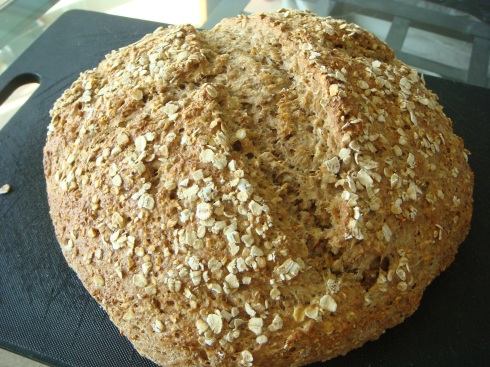The leftover buttermilk from my spiced sweet potato muffins has been calling out to me each time I open the fridge. Visions of scones and buttermilk pancakes have been dancing in my head.
Traditional buttermilk is the liquid left behind after churning butter out of cream. Commercial buttermilk, on the other hand, is just milk with added bacteria—similar to yogurt but made with slightly different bacterial strains. When I explained this to E, he asked “Why do they call it buttermilk? They should call it yogurtmilk.” (Side note: at the time, he was slightly bitter after unknowingly adding buttermilk to his freshly brewed cup of coffee. The grimace on his face hung around for days).
If you don’t have buttermilk when your recipe calls for it, thinning plain yogurt with a bit of water or milk makes a great substitute. Alternatively, you can add 1 tsp of vinegar to 1 cup of milk and let sit for 10 minutes. Words of wisdom: the latter is better suited for muffins and loaves, NOT scones. It doesn’t give you the same thick consistency needed to hold a dough together. I learned this the hard way a couple of years ago.
Last night I finally stole some time to bake up the scones that I’ve been dreaming of for the past two weeks. I was skeptical about substituting whole wheat flour in place of all-purpose but I just HAD to do it. The result was a heartier scone than you might be used to, but still crumbly and tender. I also got away with reducing the sugar a touch. It was not missed. These scones are a nice alternative to muffins and the perfect accompaniment to tea. Or a mid-week glass of wine.
Cranberry-Orange Scones
(from The Looneyspoons Collection)
1 ½ cups all purpose whole wheat flour
½ cup oat bran
½ cup sweetened dried cranberries, chopped
1/3 ¼ cup packed brown sugar
2 tsp baking powder
1 tsp baking soda
½ tsp salt
1 cup buttermilk
2 tbsp butter, melted
2 tsp grated orange zest
½ tsp vanilla
1 egg
- Preheat oven to 400 degrees Fahrenheit. Spray a large baking sheet with cooking spray (or line with parchment paper) and set aside.
- In a large bowl, combine flour, oat bran, cranberries, brown sugar, baking powder, baking soda, and salt. Set aside.
- In a medium bowl, whisk together buttermilk, butter, orange zest, and vanilla. Add wet ingredients to dry ingredients. Stir until a soft dough is formed. Add a bit more flour if dough is too sticky. Turn dough onto a lightly floured surface. Divide into 2 pieces. Shape each piece into a ball. Place balls on baking sheet and pat dough to ¾-inch-thick circles, about 6 inches in diameter. Using a sharp knife, cut each circle into 6 wedges, but do not separate them.
- To make glaze, lightly beat egg with 1 tbsp of water in a small bowl. Brush glaze lightly over top of dough (you will use less than half of the glaze).
- Bake for 15 – 17 minutes, until scones are puffed up and golden. Cool slightly. Pull scones apart and serve warm.
Makes 12 scones. Per scone (Lisa’s tweaked recipe): 120 kcal, 3 g fat (1.5 g saturated), 3 g protein, 20 g CHO, 2.2 g fibre, 311 mg sodium.










